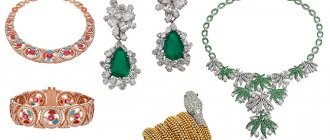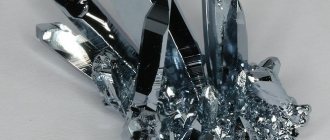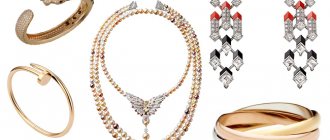LevashovaElagina
A jewelry brand at the intersection of punk and glamor, which Zhenya Levashova-Elagina founded six and a half years ago. At TSUM, her products are purchased three times more often than those of direct competitors, and Zhenya’s clients regularly write to her that her jewelry changes their lives. All this thanks to sentimental engravings like “Everything will pass, and this too” and “He who walks will master the road” - simple words that are always nice to keep somewhere close to you. “My audience is young guys who are growing up with me,” says Zhenya, who is surprisingly good at communicating with this audience. And although Levashova-Elagina herself is convinced that the success of the brand is largely due to her business skills, everything seems to be much simpler: sincerity is in fashion today, and the LevashovaElagina brand is literally imbued with it.
View on Instagram
Graff
Graff tiara with yellow and colorless diamonds
Ring with yellow and brownish-orange teardrop-shaped diamonds
Although the Graff jewelry brand appeared relatively recently, in 1960, this does not prevent it from enjoying enormous success around the world. And the fact that the company’s owner, Lawrence Graff, ranks 4th among the richest people who made a fortune in diamonds is an excellent confirmation of this. The brand's motto is “luxury, exclusivity and chic.”
Graff's favorite stone is a large, perfectly cut diamond. Therefore, it is quite expected that within the walls of his workshops some of the highest quality, largest and most expensive diamonds in the world were born:
- the largest emerald-cut diamond is the 302-carat Lesedi La Rona, derived from a 1,109-carat diamond valued at US$51 million;
- the world's largest heart-shaped diamond, the Venus, weighing nearly 119 carats;
- 132 carat yellow diamond “The Golden Empress” or The Golden Empress
All Graff jewelry is handcrafted by the finest artisans in jewelry making.
Feral Relic
In the summer of 2020, a graduate of the Higher School of Cultural Policy of Moscow State University, Mikhail Okorokov, returned to Moscow from a trip to Kamchatka. Inspired by wild landscapes, he mastered the art of jewelry and began creating unique jewelry. Okorokov’s new ideas are born while traveling. The prototype of the ring from the collaboration with the St. Petersburg brand Trustme Studio was a bent Georgian church bracelet, and the new Feral Relic collection imitates the ancient anchor stones that Misha saw in the Derbent fortress.
View on Instagram
Harry Winston is an American luxury jewelry and watch brand.
- Brand name: Harry Winston
- Year the brand was founded: 1890
- Country of origin of the brand: USA
- Type of activity: jewelry production
Today Harry Winston is very popular in many countries around the world. This jewelry brand began its history in 1890. In the 50s, the Harry Winston brand was already extremely popular; jewelry from this manufacturer was actively purchased and worn by celebrities of all stripes. All products are recognizable at first sight all over the world due to the diamond cover. A high sense of taste and a unique vision create unique images.
Today, world music and film stars are very fond of bright exclusive jewelry from Harry Winston. Harry Winston designer jewelry goes under the hammer for hundreds of thousands and even millions of dollars.
Rayya
Vera Antonova launched a brand of polished metal jewelry three years ago. Then it was called 55 Jewelry, but in 2019 there was a rebranding, and with it changes in design. From rings, earrings and pendants in the form of perfect gold plates, the emphasis has shifted to perforation, which today occupies a central place in the Rayya assortment. The brand's jewelry looks like a 3D model, but fortunately, it is more than real. And the most striking of the latest Rayya drops is a silver Lambda pendant with gold plating, released as a sign of support for the LGBT community.
View on Instagram
Top 10 jewelry chains
The main trend in the jewelry industry today is the development and expansion of online sales. In 2021, according to the Association of Internet Trading Companies, sales of precious items via the Internet increased by 60% compared to 2021, to 12 billion rubles. Marketplaces played an important role in this, pulling sales onto themselves. Jewelry is sold on such platforms as Wildberries, Lamoda, Ozon. The sites sell products from the largest Russian manufacturers, including market leader Sokolov, Moscow Jewelry, Balex and others.
Ozon noted that the company began selling jewelry in February of this year. There are currently about 10,000 product items in this category, but the retailer continues to expand its range.
“Since the launch, jewelry sales have grown on average by 40% monthly, and in July they increased by 70% compared to the first summer month. Silver items are the most popular - earrings and chains are among the top sellers, and before the start of the wedding season, the number of orders with wedding and engagement rings has increased noticeably - since May, sales of these jewelry have increased almost 3 times. Most often, Ozon clients purchase jewelry with clothing, sales of which at the end of 2021 at Ozon grew by 70% year-on-year (5 times faster than the pace of online retail in general), and at the beginning of 2021 - by 105% year-on-year.” ,” noted the Ozon press service.
Another marketplace reported that their jewelry sales increased by 50% in the first half of 2021 compared to the first half of 2021. Aliexpress also has a “jewelry” section, but unlike competitors, its assortment does not include gold products, only silver and costume jewelry. Some experts suggest that this may be the marketplace's reaction to the growing demand for silver products.
To find out why the demand for silver jewelry is growing, read the interview with Alexey Feliksov, co-owner of 585.Zolotoy.
In many retail chains, more than half of sales come from silver items (the margin on these items is several times higher than on the sale of gold jewelry).
At the same time, jewelry retailing has its own peculiarity. In Russia, Presidential Decree No. 179 of 1992 is still in force, according to which the sale of precious stones and materials is prohibited, including remote sales. And although, as Eduard Utkin, General Director of the Guild of Jewelers of Russia, previously stated in the media, this ban does not apply to jewelry, nevertheless, some regional supervisory authorities are blocking online stores selling jewelry.
Over the past few years, attempts have been made at the legislative level to remove these legal conflicts, but so far to no avail. Perhaps the situation will change this year. The Ministry of Finance has developed a draft government resolution regulating the sale of jewelry with precious stones via the Internet. Public discussions of the project ended on August 5, and the document was sent to the Russian government.
A recent report by the Russian Jewelers Guild states that there are no prerequisites for an increase in demand for jewelry in the country. Incomes of the population continue to fall (over the past 5 years, Russians have become poorer by 8.3%), debt levels are growing (about 60% of bank borrowers and 65% of MFO borrowers have difficulty repaying debts to banks and MFOs), 48.2% of families in Russia is in a consumer risk zone (there is only enough money for food and clothing), housing and communal services costs are rising. All this will affect the decrease in demand for jewelry and increased competition between jewelry manufacturers, jewelers believe. This is partly confirmed by the recent statement by the management of the Valtera chain, owned by Vladislav Kochetkov, about the closure of its own stores and the liquidation of goods with discounts of up to 90%. Valtera currently has seven of its own salons.
For the second year in a row, the company reports the liquidation of balances due to the closure of specific retail outlets, however, stores at the specified addresses are still operating.
The SunLight network periodically reports about the closure of salons and large discounts due to the liquidation of goods. The company could not be reached for comment. At the same time, market participants assure that such statements are nothing more than a marketing ploy to attract customers: for the second year in a row, the company has announced the liquidation of balances due to the closure of specific retail outlets, but the stores at the specified addresses are still operating.
In general, market participants say that today there is no talk of developing jewelry retail; companies are relocating their retail outlets: closing some stores and opening others, while practically not increasing the size of the network.
According to the Russian Jewelers Guild, in 2021, the market capacity of gold products decreased by 2.14% by weight and by 2.70% by number of products, and for silver products increased by 27.76% by weight and by 2.74 % by number of products. The average price for a piece of jewelry over the past 8 years has increased from 1,374 rubles in 2010 to 3,554 rubles in 2018.
If the consumer trend continues in 2021, the forecast for the capacity of the Russian gold and silver jewelry market in terms of the cost of the metal will be about 101.3 billion rubles, which is 0.6% less than in 2021.
Alexey Feliksov co-owner, general director of the 585.Zolotoy chain
The main trend is the development of online commerce. Leading Internet players (Wildberries, Ozon, etc.) are actively present in the market. Although their share is small in online jewelry sales (I think about 5-7%), it also has a significant impact on the market. They eat away a share of the money, plus there is a redistribution of clients, which creates nervousness.
As competition from online players increases, the least effective networks will close. In general, the market will change greatly in 2 years: a large number of large and medium-sized players will leave, and the majority of sales will go through online channels.
Our company is currently experimenting with its assortment; we are expanding into all related areas - watches, optics, accessories, costume jewelry. I think we'll add cosmetics too.
We are also actively increasing our production volumes. Over the course of a year, we rose in the ranking of gold jewelry manufacturers from somewhere from 10th position to 2nd after Sokolov (processes hundreds of kilograms of gold and a ton of silver per month).
Top 10 jewelry chains
1. "585.
Gold". The company left the 585 holding, founded in 2000 by St. Petersburg entrepreneur Alexander Smirnov. In 2006, St. Petersburg businessmen Anton Petrov and Alexey Feliksov became Smirnov’s partners. In 2011, three co-owners divided the business: Alexander Smirnov began to develop the chain under the brand “585. Gold", and Anton Petrov with Alexey Feliksov - under the brand "585. Gold". Turnover “585. Zolotoy" in 2021 exceeded 30 billion rubles, including franchising. The network has 928 points.
2. Sunlight.
Part of the Moscow Onyx Group of Companies, founded in 2000. According to Kontur Focus, ONIX Trading LLC (operator of the Sunlight network) belongs to Sergei Gribnyakov.
Initially, the company worked as a distributor of Russian and foreign jewelry manufacturers, and in 2005, the business owners founded their own jewelry brand, Sunlight. The first store opened in 2009. Currently there are 397 retail outlets operating. This is the first Russian retailer to operate in a hypermarket format. The network’s revenue in 2021 amounted to almost 9 billion rubles.
3. Moscow Jewelry Plant was founded in 1993 and is the predecessor of one of the oldest jewelry enterprises in Russia - the Moscow Jewelry Factory (founded in 1920).
MUZ OJSC is 98.6% owned by Ruiz Group of Companies LLC (owned by a Cyprus offshore company). The group of companies, which includes MUZ, carries out a full cycle of operations - from processing raw materials to selling finished products. MUZ has its own retail network - more than 300 stores in Russia. Since 2021, the company is relying on its own production, the share of which has increased by 50% in the assortment since 2015. The revenue of OJSC "MUZ" in 2021 amounted to 8.8 billion rubles (in 2021 - 9.5 billion rubles), net profit - 1.5 billion rubles. 4. Pandora.
Founded by the famous entrepreneur, ex-owner of the Svyaznoy group Maxim Nogotkov in 2010. After the businessman went bankrupt, his assets went to pay for his debts. The holding company Trellas Enterprises, owned by Nogotkov, came under the control of Oleg Malis. Among the assets was the Pandora network (PanClub JSC), whose shares were pledged to Sberbank. In November 2021, Malis, in an interview with RBC magazine, stated that his main task related to the Pandora brand is to return money to Sberbank. The network’s revenue in 2017 was 6.4 billion rubles. The chain currently has 297 stores.
5. "585. Gold."
The St. Petersburg company was founded in 2000 by entrepreneur Alexander Smirnov. The network’s revenue in 2021, according to RBC Market Research, is 3.1 billion rubles. It currently has 250 stores in Russia.
6. "Adamas"
The plant was founded in 1993. The first jewelry store was opened in Sochi in 1994. In 2015, bankruptcy proceedings were initiated against the network operator Adamas-Juvelir LLC at the request of Otkrytie Bank; other legal entities of the Adamas holding also went through bankruptcy proceedings. By decision of the Moscow Arbitration Court on May 11, 2017, Adamas Jeweler LLC was declared bankrupt. The register of claims of the debtor's creditors includes claims in the total amount of 28.4 billion rubles. The debtor's bankruptcy estate (all his property) was formed in the amount of 4.2 billion rubles. In July 2021, the court will complete bankruptcy proceedings, and the claims of creditors that were not satisfied due to the insufficiency of the debtor’s property will be considered extinguished. This legal entity is in the process of liquidation. The company continues to operate under other legal entities. The network has 200 salons in Russia. In 2021, Adamas announced plans to open franchise stores in Belarus and Kazakhstan, but this project was not implemented.
7. "Almaz-Holding".
The company was founded in 1993. Products for the chain, which consists primarily of franchise stores, are produced by Krasnoselsky Yuvelirprom. The chain has 200 stores. The plant, founded in 1919, is located in the jewelry capital - the village of Krasnoe-on-Volga, Kostroma region.
8. “Line of Love.”
The network belongs to Nadezhda Ryzhenko (operates as an individual entrepreneur, registered in 2015 in the Kostroma region). According to RBC Market Research, the chain’s revenue in 2021 amounted to 2.8 billion rubles. The chain has 133 stores in Russia.
9. “Our gold.”
The company was founded in 1999 in the Samara region by Andrey Borisov (operating as an individual entrepreneur). The chain has 118 stores in Russia.
10. “Red gold.”
The chain belongs to a jewelry store established in 2011 in the village of Krasnoe-on-Volga, Kostroma Region. The first store of the chain was opened in 2021. The company belongs to Evgeny Dmitriev. Revenue in 2021 is 45.8 million rubles, and net profit is 1.6 million rubles, according to SPARK. The network has 93 salons in Russia.
Himere
Himère founder Dina Sagidullina calls her weightless fine line jewelry modern talismans. True, she herself does not endow them with otherworldly powers, leaving this to her clients. But her geometric rhodium earrings from the basic collection have at least one undeniably magical ability - to please the eye. Like the first collection in rose and white gold, which included three pendants in the form of a moon with a rose, stars with an orchid and a small cross covered with flowers. The latter, by the way, are Dina’s own favorites: “As usual, the new collection is always the most beloved.”
View on Instagram
Download the new issue of Vogue to always have it at hand - for iOS and Android.









